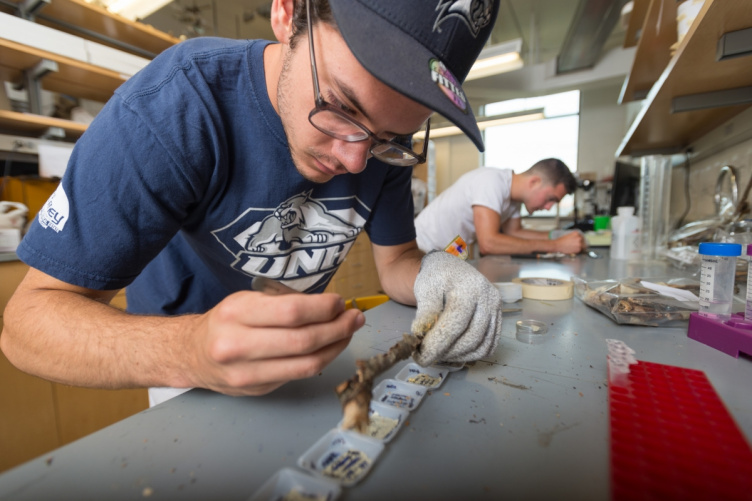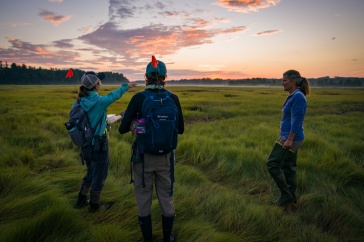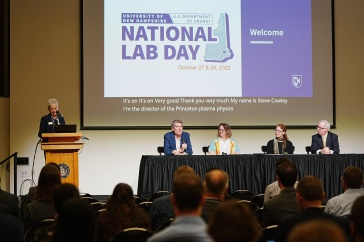
What’s going on inside your rose stems might surprise you.
Open one up and you might find an insect, or two or three, in various stages of growth, nestled within the walls. The entire lifecycle of the small carpenter bee, for example, occurs inside the dead stems of roses and other woody plants such as sumac and raspberries.
Never heard of the small carpenter bee? You’re not alone. Their solitary ways have made them less common to study than their showier cousins. We know a lot about the highly social honeybee—with its communal childcare, clever queen-replacement techniques, and cutthroat population-control mechanisms—but there’s a relative dearth of insight on the less gregarious bees.
Sandra Rehan and Sean Lombard are doing something about that.
Rehan is a bee expert and assistant professor of biology at the UNH College of Life Sciences and Agriculture. Lombard just finished his freshman year as a pre-med major at UNH. He’s working full-time in the field and lab this summer researching the small carpenter bee, Ceratina calcarata.
“The small carpenter bees can tell us something about why some insects have evolved to become highly social and others not. That is still an open question,” says Rehan. “This bee is at the brink of sociality.”
The brink of sociality, meaning the small carpenter is neither solitary nor social. Lombard explains that a truly solitary bee takes more of a “lay ‘em and leave ‘em” approach to child-rearing—providing only the bare necessity of care for only the minimum amount of time necessary for survival. By contrast, small carpenters continuously guard their young and provide nourishment and care through the entire development phase. This prolonged maternal care is what characterizes them as “sub-social.”

70 Days of Foraging
Rehan is into bees. She’s been studying them since 2004. On the pale blue walls of her first-floor Rudman Hall office hang striking portraits of four native bees—the sweat bee, leafcutter bee, small carpenter bee and large carpenter bee—against jet-black stretched canvases.
Lombard places two halves of a one-centimeter diameter stem that he collected this morning on Rehan’s desk and points to a tiny hole a bee created to enter and exit. When he’s in the field collecting stems, he tapes over the hole to prevent his research subject from escaping during transit to the lab.
Even though it’s only 10:30, Lombard has already collected and processed 30 sumac stems (a “low-yield” day, he says) from Site 18, one of the almost two-dozen sites where he forages for nests. He starts early because as soon as the sun comes above the horizon and the temperature rises, the bees themselves are out foraging.
Once he has a bundle, he brings them to Rudman Hall’s cold room and begins processing the nests. First he chills the stems, then he splits them in half lengthwise. He transfers the adult bee to a chilled tube—the chilling immobilizes her—and then swabs her with either water or Pentane. Pentane removes the cuticular hydrocarbons (CHCs) from the bee’s waxy cuticle. CHCs are key to Lombard’s study. He wants to find out if reproductive females have similar CHC levels to the reproductive females in highly social species and if non-reproductive females have different CHC levels than their reproductive peers.
Removing the CHCs also helps prepare the bee for the behavioral part of the study, where Lombard places two reproductive females in a tube and observes for aggression.
All of this takes about eight hours.
Beedazzled
Lombard and Rehan hypothesize that the removal of CHCs will result in reduced aggression.
Regardless of the outcome, the data Lombard is amassing will shed more light on an understudied topic and could lead to more behavioral genomic experiments that would get researchers closer to answering that big unanswered question in evolutionary biology: How and why did some insects morph to become highly social?
This is Lombard’s summer job. He got a REAP award to do it. REAP is the Research Experience and Apprenticeship Program, which funds 10 weeks of full-time summer research work and associated expenses. He says he learned about REAP at a good time.
“I was wondering what to do for the summer. I didn’t want to work retail again, and I knew I wanted to try research.” He says he looked at the research different professors were doing, got excited about the bee project, and applied.
“I don’t consider this work,” he says. “It’s so much better than that.”
Professor Rehan’s research is funded by the NH Agricultural Experiment Station.
Related:
New Bee “Hotel” at UNH is Reserved for Pollinators
UNH Hamel Center for Undergraduate Research

-
Written By:
Tracey Bentley | Communications and Public Affairs



















































